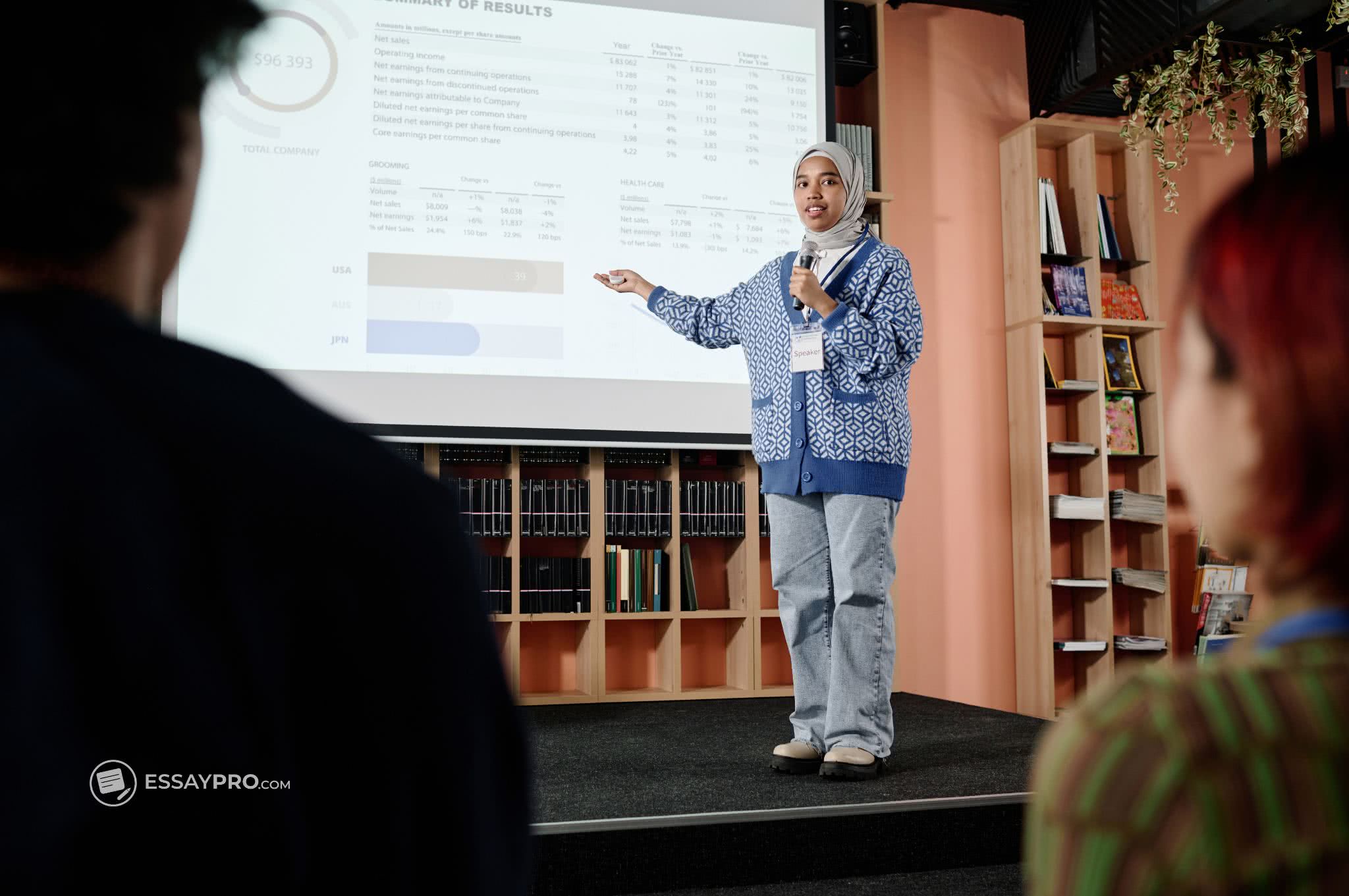7 Key PowerPoint Presentation Tips for Student Success

Imagine this—you’ve spent hours creating your PowerPoint. The content is solid, but as you present, your classmates lose interest. Eyes wander, phones light up, and suddenly, you’re rushing through slides just to finish. Often, the issue isn’t the quality of your research but rather poor design, cluttered slides, or a boring delivery that overshadows your great content.
Mastering PowerPoint isn’t just about fancy visuals; it’s about clarity, engagement, and storytelling. Students seeking to elevate their presentations should focus on conveying their message effectively. To that end, PowerPoint presentation tips and tricks become essential tools. EssayPro has compiled expert advice to help students craft presentations that not only capture attention but also leave a lasting impression, ensuring their hard work truly shines.
1. Start Strong with a Captivating Hook
The importance of a compelling opening cannot be overstated. A strong start is crucial for grabbing the audience’s attention from the very first slide. When considering how to start a presentation, think beyond simply stating your topic. Instead, consider asking a thought-provoking question, sharing a surprising statistic, or telling a short, relevant anecdote. For example, “Did you know people remember only 10% of what they hear but 65% of what they see?” Such a statistic immediately highlights the importance of visual aids. An engaging hook sets the tone for the entire presentation, ensuring the audience is invested and ready to learn more.
2. Craft a Compelling Narrative
A well-structured narrative is essential for keeping listeners engaged throughout the presentation. To achieve this, students can employ the classic “3-Act Structure.” First, the introduction should present the topic and immediately grab the audience’s attention. Next, the body of the presentation should present key points supported by evidence, allowing for a logical flow of information. Finally, the conclusion should reinforce the key takeaways with a memorable closing statement, ensuring the audience retains the most important information.
Storytelling techniques, such as building suspense, posing rhetorical questions, or using relatable examples, can make complex ideas more digestible. When considering tips for a good PowerPoint presentation, this narrative approach is vital.
For students who find creating such presentations challenging, services like EssayPro offer a convenient solution, allowing them to easily outsource PowerPoint presentations and ensure a professional and engaging result.
3. Design for Clarity, Not Clutter
Design in PowerPoint is more than just aesthetics; it’s about enhancing understanding and ensuring your message resonates. Minimalism often works best: fewer words and more impactful visuals allow the audience to focus on the key points. A useful guideline is the 6x6 Rule: no more than six bullet points per slide and no more than six words per point. Employing bold fonts, contrasting colors, and consistent slide layouts significantly improves readability, making the presentation more accessible. Tools like Canva or pre-designed PowerPoint templates can simplify the design process, allowing students to create visually appealing slides without extensive design skills.

However, it’s crucial to avoid overloading slides with animations; use them sparingly and strategically for emphasis. A good presentation example will prioritize clarity and visual hierarchy over excessive ornamentation. Remember, the goal is to guide the audience’s attention, not overwhelm it.
4. Visualize Your Data
Impactful visuals are a powerful tool in any presentation. High-quality images, infographics, and diagrams can significantly enhance understanding and engagement. Visuals should complement, not replace, the spoken words. For instance, instead of listing statistics in text, a vibrant pie chart or graph can convey the same information more effectively. Clear labeling of visuals is essential for ensuring the audience understands the data being presented. Different presentation styles will utilize visuals in varying ways, but the principle remains the same: visuals should enhance, not distract from, the core message.
5. Encourage Audience Interaction
Interaction significantly boosts engagement. Asking questions, inviting opinions, or including short, relevant activities can transform a passive audience into active participants. For example, when discussing climate change, asking, “What’s one simple action you’ve taken to reduce your carbon footprint?” prompts thoughtful responses. Humor, used appropriately, can also build rapport and create a more relaxed atmosphere. Incorporating these tips for PowerPoint presentation ensures that the audience remains actively involved and connected to the material.
6. Prepare for Technical Glitches
Technical issues can derail even the most polished presentations. Testing slides on the presentation device in advance is crucial. This includes verifying that all multimedia elements, such as videos and audio, function correctly. Backup solutions are equally important; save the presentation on a USB drive, email it, and upload it to the cloud. Ensuring compatibility across different devices and software versions can prevent last-minute surprises.
Arriving early to check equipment and internet connectivity ensures a smooth start, allowing time to troubleshoot any potential problems. Knowing how to create a PowerPoint presentation includes being prepared for unforeseen technical challenges and having contingency plans in place. This proactive approach ensures that the presentation’s flow remains uninterrupted, maintaining the audience’s engagement.
Common Pitfalls to Avoid: EssayPro’s Insights
Presentations can quickly lose their impact if common errors are overlooked. Here are five frequent mistakes to avoid:
- Cluttered slides
- Reading directly from slides
- Rushing through content
- Lack of practice
- Ignoring audience engagement
By prioritizing clarity, practicing delivery, and ensuring audience engagement, presenters can avoid these pitfalls and create impactful presentations. This means using visuals to enhance, not replace, spoken content, and actively seeking audience participation. Effective presenters understand that a successful presentation is about connecting with the audience and leaving a lasting impression.
So, mastering PowerPoint presentations involves a blend of compelling content, thoughtful design, and confident delivery. By applying these tips, students can create impactful presentations that resonate with their audience. Developing strong presentation skills is an invaluable asset for academic and professional success. For students seeking expert assistance, EssayPro offers professional services to help craft outstanding presentations, ensuring their hard work is showcased effectively.